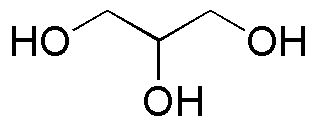Glycerol is widely utilized in research focused on:
- Pharmaceuticals: It serves as a key ingredient in many medications, acting as a solvent and humectant, which helps maintain moisture and stability in formulations.
- Cosmetics and Personal Care: Glycerol is commonly found in skin care products due to its moisturizing properties, making it ideal for creams, lotions, and soaps.
- Food Industry: It acts as a sweetener and preservative in various food products, enhancing flavor and texture while also extending shelf life.
- Biotechnology: In laboratory settings, it is used as a cryoprotectant for preserving biological samples, ensuring cell viability during freezing processes.
- Industrial Applications: Glycerol is utilized in the production of antifreeze and plastics, providing flexibility and durability to materials while being more environmentally friendly compared to some alternatives.
General Information
Properties
Safety and Regulations
Applications
Glycerol is widely utilized in research focused on:
- Pharmaceuticals: It serves as a key ingredient in many medications, acting as a solvent and humectant, which helps maintain moisture and stability in formulations.
- Cosmetics and Personal Care: Glycerol is commonly found in skin care products due to its moisturizing properties, making it ideal for creams, lotions, and soaps.
- Food Industry: It acts as a sweetener and preservative in various food products, enhancing flavor and texture while also extending shelf life.
- Biotechnology: In laboratory settings, it is used as a cryoprotectant for preserving biological samples, ensuring cell viability during freezing processes.
- Industrial Applications: Glycerol is utilized in the production of antifreeze and plastics, providing flexibility and durability to materials while being more environmentally friendly compared to some alternatives.
Documents
Safety Data Sheets (SDS)
The SDS provides comprehensive safety information on handling, storage, and disposal of the product.
Product Specification (PS)
The PS provides a comprehensive breakdown of the product’s properties, including chemical composition, physical state, purity, and storage requirements. It also details acceptable quality ranges and the product's intended applications.
Certificates of Analysis (COA)
Search for Certificates of Analysis (COA) by entering the products Lot Number. Lot and Batch Numbers can be found on a product’s label following the words ‘Lot’ or ‘Batch’.
*Catalog Number
*Lot Number
Certificates Of Origin (COO)
This COO confirms the country where the product was manufactured, and also details the materials and components used in it and whether it is derived from natural, synthetic, or other specific sources. This certificate may be required for customs, trade, and regulatory compliance.
*Catalog Number
*Lot Number
Safety Data Sheets (SDS)
The SDS provides comprehensive safety information on handling, storage, and disposal of the product.
DownloadProduct Specification (PS)
The PS provides a comprehensive breakdown of the product’s properties, including chemical composition, physical state, purity, and storage requirements. It also details acceptable quality ranges and the product's intended applications.
DownloadCertificates of Analysis (COA)
Search for Certificates of Analysis (COA) by entering the products Lot Number. Lot and Batch Numbers can be found on a product’s label following the words ‘Lot’ or ‘Batch’.
*Catalog Number
*Lot Number
Certificates Of Origin (COO)
This COO confirms the country where the product was manufactured, and also details the materials and components used in it and whether it is derived from natural, synthetic, or other specific sources. This certificate may be required for customs, trade, and regulatory compliance.

